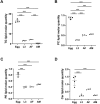The developmental lipidome of Nippostrongylus brasiliensis
- PMID: 39863914
- PMCID: PMC11762861
- DOI: 10.1186/s13071-024-06654-2
The developmental lipidome of Nippostrongylus brasiliensis
Abstract
Background: Nippostrongylus brasiliensis-a nematode of rodents-is commonly used as a model to study the immunobiology of parasitic nematodes. It is a member of the Strongylida-a large order of socioeconomically important parasitic nematodes of animals. Lipids are known to play essential roles in nematode biology, influencing cellular membranes, energy storage and/or signalling.
Methods: The present investigation provides a comprehensive, untargeted lipidomic analysis of four developmental stages/sexes (i.e. egg, L3, adult female and adult male stages) of N. brasiliensis utilising liquid chromatography coupled to mass spectrometry.
Results: We identified 464 lipid species representing 18 lipid classes and revealed distinct stage-specific changes in lipid composition throughout nematode development. Triacylglycerols (TGs) dominated the lipid profile in the egg stage, suggesting a key role for them in energy storage at this early developmental stage. As N. brasiliensis develops, there was a conspicuous transition toward membrane-associated lipids, including glycerophospholipids (e.g. PE and PC) and ether-linked lipids, particularly in adult stages, indicating a shift toward host adaptation and membrane stabilisation.
Conclusions: We provide a comprehensive insight into the lipid composition and abundance of key free-living and parasitic stages of N. brasiliensis. This study provides lipidomic resources to underpin the detailed exploration of lipid biology in this model parasitic nematode.
Keywords: Nippostrongylus brasiliensis; Adaptation; Gastrointestinal nematode; Lipidome; Lipids; Mass spectrometry; Rodent.
© 2025. The Author(s).
Conflict of interest statement
Declarations. Ethics approval and consent to participate: The animal ethics approval for sample collection was obtained from Monash University (permit no. E/1843/2018/M). Consent for publication: Not applicable. Competing interests: The authors declare no competing interests.
Figures





References
-
- Loukas A, Hotez PJ, Diemert D, Yazdanbakhsh M, McCarthy JS, Correa-Oliveira R, et al. Hookworm infection. Nat Rev Dis Primers. 2016;2:16088. 10.1038/nrdp.2016.88. - PubMed
-
- Gasser RB, von Samson-Himmelstjerna G. Haemonchus contortus and Haemonchosis – Past, Present and Future Trends. Adv Parasitol. 2016. 93.
-
- Charlier J, Bartley DJ, Sotiraki S, Martinez-Valladares M, Claerebout E, von Samson-Himmelstjerna G, et al. Anthelmintic resistance in ruminants: challenges and solutions. Adv Parasitol. 2022;115:171–227. 10.1016/bs.apar.2021.12.002. - PubMed
-
- Kotze AC, Prichard RK. Anthelmintic resistance in Haemonchuscontortus: History, mechanisms and diagnosis. Adv Parasitol. 2016;93:397–428. 10.1016/bs.apar.2016.02.012. - PubMed
MeSH terms
Substances
Grants and funding
LinkOut - more resources
Full Text Sources
Research Materials

